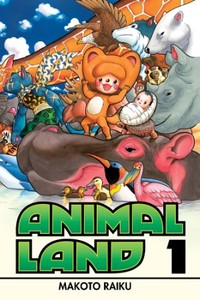Review
by Rebecca Silverman,Animal Land
GN 1
| Synopsis: |  |
||
Deep in the heart of the animals' forest live a tribe of tanuki. Young Monoko has lost her parents to a wild cat attack and feels lost and alone. Then one day she fishes an abandoned human baby out of the river. Determined to make him her family, Monoko adopts the boy and sets out to raise him. Much to her surprise, despite being an infant the child can speak to the tanuki...and even more surprising, he can speak the languages of all of the other animals as well. |
|||
| Review: | |||
Readers of Viz's release of the Zatch Bell shonen tournament manga may be surprised when they look at the author of Kodansha's latest. Makoto Raiku says in the afterward of Animal Land's first volume that he is trying to tackle difficult issues not often seen in manga and admits that he is somewhat surprised to find himself writing an animal story. But branching out can often reap large rewards, and that is definitely the case here as Raiku sets out into uncharted territory. The story opens with a human woman setting her newborn afloat on the river. This is not some strange variation on the Passover story – she is deliberately abandoning a baby that she wishes were never born. This may be one of the “difficult themes” Raiku is dealing with, and he handles it admirably. The mother's face is distorted when seen through the eyes of the infant, giving her an inhuman appearance that is perfectly in line with her inhumane act. Later the baby flashes back to that moment, remembering her words, which were absent in the opening pages. Suffice it to say that they are in line with her actions, effectively creating the scenario every child who has awoken alone imagines in panic. This is not the only childhood nightmare brought to life on the page – tanuki Monoko's parents, we are told early on, were eaten by wild cats, a scene Raiku shows us several times. While there is no blood, the image of her parents dangling from the mouths of ravenous beasts will stick with you. There is no sweet fiction about the animal kingdom here; the strong eat the weak and that's just the way it goes. The juxtaposition of the casual attitude of the carnivorous beasts and the fear of the prey may call to mind other, more “human” situations, a similarity that the afterward asserts is deliberate on the author's part. Raiku wants his story's world to make us a little uncomfortable, and in this he does succeed. That is not to say that this is a perfectly constructed story. There are some strange discrepancies that may haunt readers just as much as the disturbing images, things like the uncertain size of the tanuki. At some points Monoko looks nearly as large as the baby; in others she is clearly much larger. Her age is also uncertain – she refers to her parents as “Mommy” and “Daddy” but appears to be the same size as most of the clearly adult tanuki. Then again, some of the older females have breasts, while Monoko herself is flat chested. The safest assumption seems to be “teenager,” but some of her younger mannerisms make that, at times, unlikely. Another issue is that the majority of the animals are unclothed, but Kurokagi, one of the wild cats, wears pants, a shirt, and a scarf. Of course, since he is larger than most of the other animals who have thus far appeared in the story, there may be a supernatural element to his character that simply has yet to be revealed. Artistically this is a mixed bag. Most of the animals look like animals, but the tanuki are drawn as if they are humans dressed as animals, with mostly human faces and bosoms on some of the females. When no other creatures are present, it works quite well, but when cows or jackals show up it becomes more difficult to accept. Backgrounds, on the other hand, are lush and do an excellent job of evoking the forest where the story is played out. At this point it seems like a perfectly ordinary place (although the presence of cows is a bit odd), but there are hints that it may be more than it seems, including a particularly troubling one in the opening scene. One of the most interesting aspects of the story's world is the way that different species of animals cannot communicate with each other. Monoko explains that they all have “different cries;” that is, they all make different sounds. While this may cause readers raised on “Garfield” pause, it likely contributes to that timeliness mentioned by the author. (Have you noticed that the afterward is a wealth of information?) That only the baby can communicate with multiple species is sure to be important as the story moves forward. While Animal Land carries a “T” rating it could certainly be enjoyed by a younger audience. If you give it to your child, just be sure to be on hand for the more troubling aspects, as it will bother some children. But overall Makoto Raiku's foray into a different genre is an interesting read that makes good use of animals to tell a very human story. |
| Grade: | |||
|
Overall : B+
Story : B+
Art : B
+ Good handling of the darker side of societies using animals to make a human metaphor, nice backgrounds, and an excellent afterward. |
|||
| discuss this in the forum (4 posts) | | |||
| Production Info: | ||
|
Full encyclopedia details about Release information about |
||